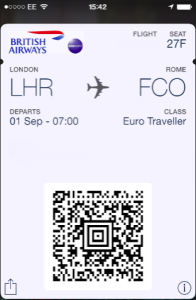Just a few years ago, you would find that the most high-tech piece of equipment at an airport for travellers would be pay phones or fax machines filling terminal walls with ugly plastic boxes. However, times have changed with the technical age and now airports are entering the 21st century with some of the most innovative technologies in the world. We take a look at how technology has improved the world of travel in these changing times.
10 years ago, to check into your journey you would have to arrive hours before your flight and join an endless queue of equally bored individuals and families (and you would not have had a mobile phone to entertain you and your group). However, incessant queuing is no more as check-in can now be done online, meaning you can print off your boarding pass and select your seat from the comfort of your own home. If you have hand luggage only, you can even walk straight through to security, into the terminal and onto the plane – cutting down the amount of time you need to spend at the airport or increasing the amount of time you can spend in duty-free if you prefer! Kiosk check-in’s are also available at most airports now so you do not even need to speak to airport staff if you have not checked in beforehand.

Even more high-tech are the mobile boarding passes offered by Easyjet and BA. This means that, using certain mobile devices, you can check in online, save the email confirmation of your boarding pass with a QR code to your mobile passbook and then use your phone as the boarding pass.
Passports have also entered the virtual age with the introduction of fandangled biometric passports which contain an electronic chip holding all of your information. Because of this, you don’t even need to speak to a person to get through passport security if you take the automatic border control system route which uses a face recognition system to check if your face matches your passport photo.
Body scanners have also been introduced at some airports, which use x-rays to check your body for illegal items. However, travellers can opt out of these scanners to use the traditional ones if they do not wish for the security checkers to view their body outline.
You can also bypass human interaction not only when getting to your flight but also when booking it. To improve communication with customers and make it easier to book flights, the majority of airlines and travel providers now offer apps for their customers. This means that where once upon a time you had to use a travel agent or phone to book a flight, you can do it with the push of a button from anywhere with an internet connection.
 With widespread internet connection has come the popularity of mobile phones, tablets and laptops, which has lead to higher security checks. Now, laptops and mobiles have to be kept separate from other luggage during the security check and airlines have had to introduce a policy whereby all mobile devices must be in airplane mode for the duration of the flight. That said, many airlines are now embracing the digital age and increase in the popularity of such devices by offering wi-fi on aircrafts, but of course they do charge for the privilege.
With widespread internet connection has come the popularity of mobile phones, tablets and laptops, which has lead to higher security checks. Now, laptops and mobiles have to be kept separate from other luggage during the security check and airlines have had to introduce a policy whereby all mobile devices must be in airplane mode for the duration of the flight. That said, many airlines are now embracing the digital age and increase in the popularity of such devices by offering wi-fi on aircrafts, but of course they do charge for the privilege.
It is an exciting time for technology in travel and who knows what will be happening 10 years from now? Will terminal staff become obsolete? Will robots take our luggage from us? Or will we be able to bypass airports entirely and simply teleport ourselves to our destination? Only the changing times will tell.
 World Airport Codes
World Airport Codes